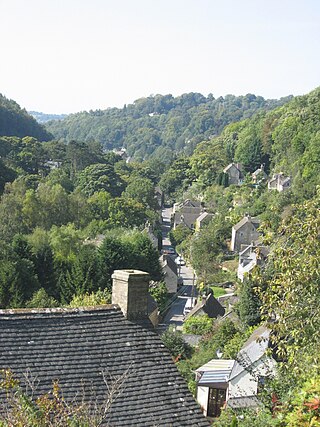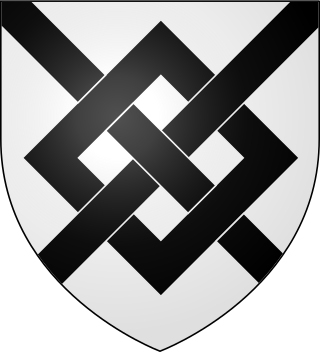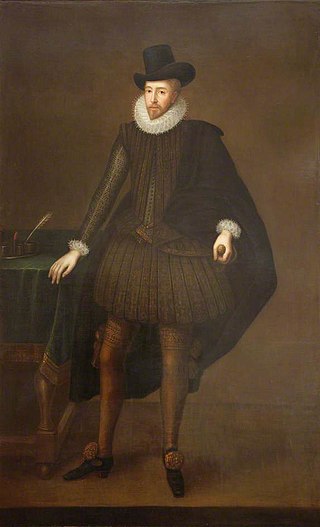
The Thames and Severn Canal is a canal in Gloucestershire in the south-west of England, which was completed in 1789. It was conceived as part of a cargo route from Bristol and the Midlands to London, linking England's two largest rivers for better trade. The route climbs the steep Cotswold escarpment through the Golden Valley, tunnels underneath the summit of the Cotswold Edge, and emerges near the source of the Thames.
The Gloucester and Sharpness Canal is a ship canal in the west of England, between Gloucester and Sharpness, completed in 1827. For much of its length the canal runs close to the tidal River Severn, but it cuts off a significant loop in the river, at a once-dangerous bend near Arlingham. It was once the broadest and deepest canal in the world. The canal is 26.5 km long.

Lechlade is a town at the edge of the Cotswolds in Gloucestershire, England, 55 miles (89 km) south of Birmingham and 68 miles (109 km) west of London. It is the highest point at which the River Thames is navigable, although there is a right of navigation that continues south-west into Cricklade, in the neighbouring county of Wiltshire. The town is named after the River Leach that joins the Thames near the Trout Inn and St. John's Bridge.
Brimscombe and Thrupp is a civil parish made up of the villages of Thrupp and Brimscombe, in the narrow Frome Valley slightly south-east of Stroud, Gloucestershire, England. The parish also includes the hamlets of Quarhouse and The Heavens. The population taken at the 2011 census was 1,830.

Chalford is a large village in the Frome Valley of the Cotswolds in Gloucestershire, England. It is to the southeast of Stroud about four miles upstream. It gives its name to Chalford parish, which covers the villages of Chalford, Chalford Hill, France Lynch, Bussage and Brownshill, spread over two square miles of the Cotswold countryside. At this point the valley is also called the Golden Valley.

Frampton on Severn is a village and civil parish in Gloucestershire, England. The population is 1,432.

Arlingham is a village and civil parish in the Stroud District of Gloucestershire, England. The 2021 Census recorded a parish population of 533. The parish contains the hamlets of Milton End, Overton and Priding. The next parish to the east is Fretherne with Saul.

The Tollemache family is an English noble family, originally from Suffolk. The family's surname is pronounced TOL-mash.
This is a list of Sheriffs and High Sheriffs of Gloucestershire, who should not be confused with the Sheriffs of the City of Gloucester.

Constable Burton Hall is a Grade I-listed Georgian country house of dressed stone in an extensive and well wooded park in the village of Constable Burton in North Yorkshire, designed by John Carr of York in 1768. It is privately owned by the Wyvill family. The house is a two-storey ashlar-faced structure with a five bay frontage having an elegant recessed Ionic portico. The principal entrance is approached by a double flight of steps. The side elevation has a pediment and there is a large projecting bay to the rear of the house.
Sir Charles Nicholas Mander, 4th Baronet is a British baronet, historian and businessman.
There have been two baronetcies created for persons with the surname Darell, one in the Baronetage of England and one in the Baronetage of Great Britain. As of 2014 one creation is extant.

Titsey Place is an English country house near Oxted in Surrey, England. It was successively the seat of the Gresham and Leveson-Gower families and is now preserved by a charitable trust for the nation.

Baptist Hicks, 1st Viscount Campden was an English cloth merchant and politician who sat in the House of Commons between 1621 and 1628. King James I knighted Hicks in 1603 and in 1620 he was created a baronet.

The round houses on the Thames and Severn Canal are five former lengthsmen's cottages built along the canal between Chalford and Lechlade in Gloucestershire, England. Constructed in the 1790s when the canal was built, all but one of them are Grade II listed and have been restored as private dwellings. The buildings have been described as "peculiar" and "a distinctive feature of the Thames and Severn Canal's architecture".
Colonel Sir Lionel Edward Hamilton Marmaduke Darell, 6th Baronet DSO JP DL was an English soldier and landowner.
Captain Sir Lionel Edward Darell, 5th Baronet JP DL was an English landowner and soldier.
Sir Lionel Darell, 1st Baronet was an English politician and East India Company official.
The Reverend Sir William Lionel Darell, 4th Baronet JP, was an English clergyman who served as rector of Fretherne.

Sir Edward Tierney, 2nd Baronet was an Irish lawyer and landowner.











